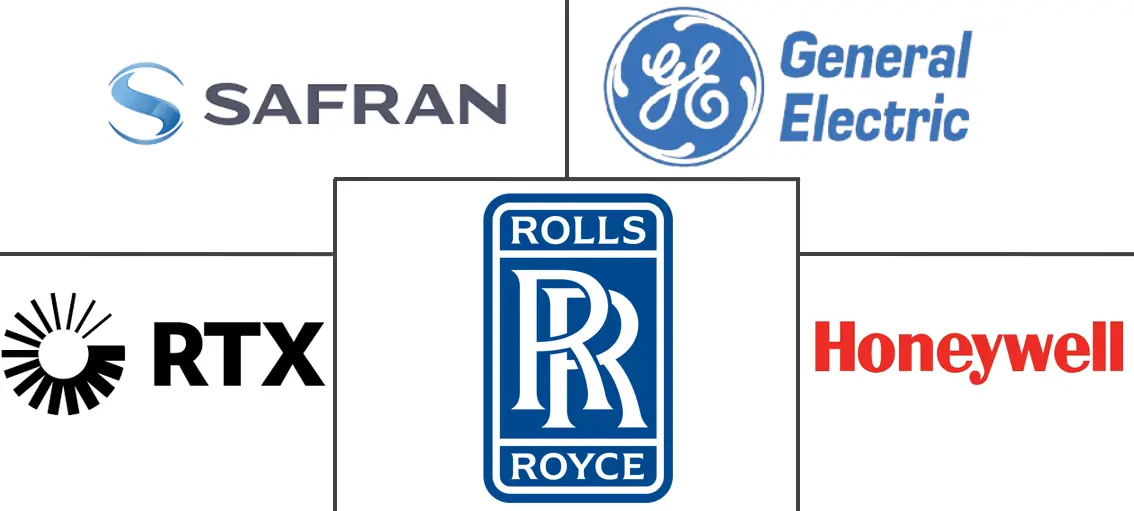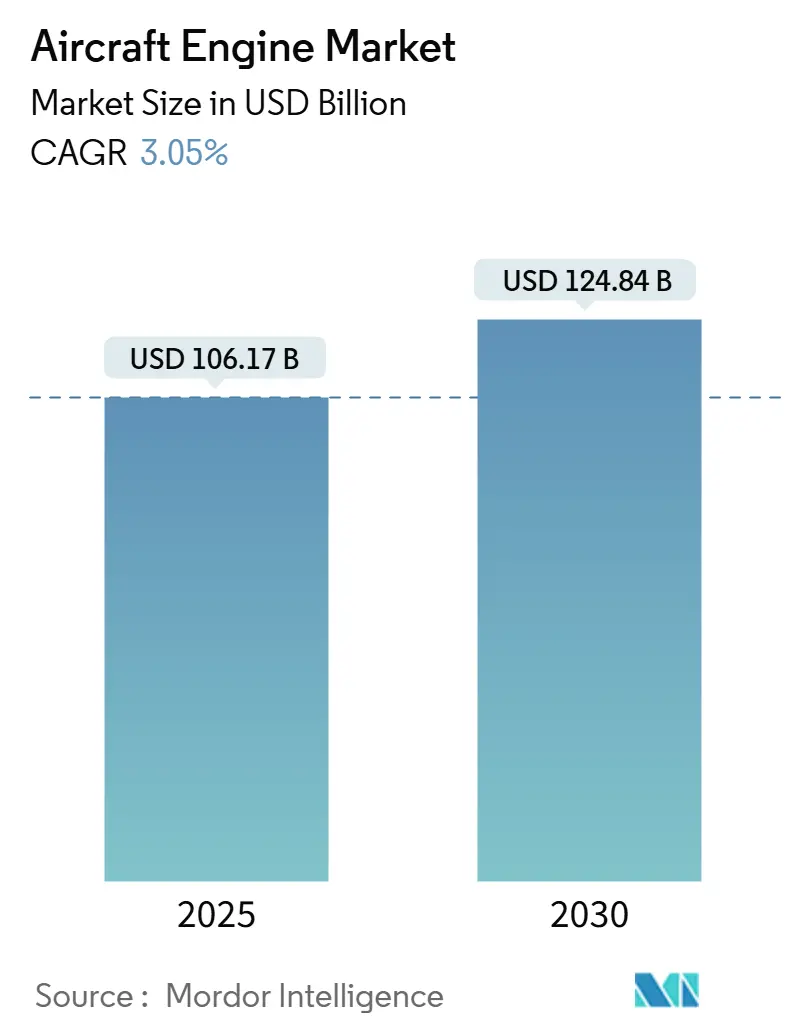
Aircraft Engine Market Analysis by Mordor Intelligence
The aircraft engine market size was USD 106.17 billion in 2025 and is expected to reach USD 124.84 billion by 2030, growing at a 3.05% CAGR. Demand recovery in long-range commercial programs, renewed narrowbody backlogs, and military tanker upgrades, combined with fleet-wide sustainability objectives, will sustain this moderate expansion. Twin-aisle production is returning to normal after the pandemic pause. At the same time, airlines accelerated the replacement of older engines with fuel-efficient LEAP and GTF models to contain operating costs and meet emissions targets. The Asia-Pacific remains the primary growth engine, while Middle-East carriers drive the fastest regional trajectory. Sustained defense modernization across NATO members underpins the military segment. Supply-chain bottlenecks in castings and forgings remain a limiting factor; however, targeted investment in additive manufacturing and dual sourcing has begun to ease the tightest constraints.
Key Report Takeaways
- By engine type, turbofan units led the aircraft engine market, accounting for a 64.45% share in 2024. In contrast, hybrid-electric propulsion is projected to rise at a 7.51% CAGR through 2030.
- By aircraft type, the commercial narrowbody segment accounted for 43.35% of the aircraft engine market size in 2024; advanced air mobility vehicles are set to expand at a 9.06% CAGR through 2030.
- By technology, geared-turbofan designs held a 36.13% revenue share in 2024, while adaptive-cycle engines showed the fastest growth, with a 9.15% CAGR from 2025 to 2030.
- By thrust class, the 25,001 to 50,000 lbf bracket captured 40.5% of the aircraft engine market share in 2024, while the greater than 50,000 lbf category will advance at a 7.05% CAGR up to 2030.
- By component, turbine assemblies represented 36.75% of 2024 revenue, and gearboxes are forecasted to post a 5.5% CAGR through 2030.
- By end-user, OEM factory-fit segments held 55.14% of the aircraft engine market in 2024; replacement/aftermarket segments are projected to show the fastest growth, with an 8.45% CAGR to 2030.
- By geography, the Asia-Pacific region commanded 33.21% of the global value in 2024; the Middle East is projected to grow at a 6.75% CAGR through 2030.
Global Aircraft Engine Market Trends and Insights
Drivers Impact Analysis
| Driver | (%) Impact on CAGR Forecast | Geographic Relevance | Impact Timeline |
|---|---|---|---|
| Emerging twin-aisle production ramp-up post-supply-chain recovery | +0.8% | Global; concentration in North America and Europe | Medium term (2-4 years) |
| Fleet-wide shift toward LEAP and GTF engines in fast-growing Asian carriers | +0.6% | Asia-Pacific core; spill-over to Middle East | Short term (≤ 2 years) |
| NATO transport- and tanker-fleet modernization programs boosting military engine demand | +0.4% | North America and European Union | Long term (≥ 4 years) |
| Helicopter fleet renewal for offshore energy operations raising turboshaft deliveries | +0.3% | Global offshore regions; North Sea and Gulf of Mexico | Medium term (2-4 years) |
| EU mandates for 100% SAF-ready engines in new type certificates | +0.5% | European Union primary; global secondary impact | Long term (≥ 4 years) |
| Leasing-driven expansion of African regional-jet operators | +0.2% | Africa; connections to European lessors | Medium term (2-4 years) |
| Source: Mordor Intelligence | |||
Twin-aisle production ramp-up boosts demand
Output targets set by Airbus and Boeing for 2026 mark the clearest signal that widebody assembly lines are returning to their pre-pandemic cadence. Engine makers must increase their weekly throughput while navigating lingering raw material shortages. CFM disclosed that 2024 LEAP deliveries trailed demand by 10%, though tier-1 suppliers are now shipping more than 90% of the scheduled volume, indicating gradual normalization.[1]FlightGlobal Staff, “LEAP Production Update,” flightglobal.com Advances in additive-manufactured fuel nozzles and broader dual-source strategies aim to close the gap within two years.
Rapid LEAP and GTF uptake in Asia-Pacific
Fleet expansion across India, Vietnam, and Malaysia has produced the world’s densest pipeline of single-aisle orders. IndiGo’s purchase agreement for 280 LEAP-1A engines and VietJet’s commitment to more than 400 LEAP-1B units underscore the preference for high-bypass, low-fuel-burn propulsion.[2]Safran Group, “LEAP Engine Backlog and RISE Testing,” safrangroup.com CFM shipped 1,570 LEAP engines in 2023 and retains an order backlog exceeding 10,600 units, providing near-term production visibility and reinforcing the narrative in the aircraft engine market around Asian carrier growth.
NATO modernization programs elevate military requirements
The KC-46A Pegasus tanker, A330 MRTT fleet expansion, and Portugal’s KC-390 Millennium orders collectively add dozens of high-thrust powerplants to the order book. Long-duration service contracts secure spares and overhaul revenue streams, providing OEMs with predictable aftermarket volumes. These initiatives also harmonize maintenance procedures across alliance members, elevating commonality in the aircraft engine market.
EU sustainable-aviation-fuel legislation reshapes design rules
ReFuelEU Aviation introduces staged mandates, climbing from a 2% SAF blend in 2025 to 70% by 2050, and sets a 0.7% synthetic-fuel sub-target in 2030.[3]European Commission, “ReFuelEU Aviation Regulation,” ec.europa.eu Engine makers have completed extensive 100% SAF certification campaigns, and flight-test programs with GE Aerospace highlight drop-in compatibility. Tradeable credits incentivize early compliance and accelerate R&D into combustion-system adaptations, directing capital toward technologies that lower lifecycle emissions in the aircraft engine market.
Restraints Impact Analysis
| Restraint | (%) Impact on CAGR Forecast | Geographic Relevance | Impact Timeline |
|---|---|---|---|
| Persistent casting and forging bottlenecks limiting turbine-blade availability | −0.7% | Global; concentrated in US and European supply chains | Short term (≤ 2 years) |
| High-temperature durability issues in hot-and-high Middle-East operations | −0.4% | Middle East and North Africa; extending to South Asia | Medium term (2-4 years) |
| Slow standardization of hydrogen-combustion engine architectures | −0.3% | Global; EU leading regulatory development | Long term (≥ 4 years) |
| Margin pressure from independent MRO capacity growth | −0.5% | Global; most pronounced in mature markets | Medium term (2-4 years) |
| Source: Mordor Intelligence | |||
Casting and forging capacity shortfalls restrict output
Specialty alloy turbine blades remain the key factor in achieving higher monthly production. Howmet Aerospace reported schedule slips affecting narrowbody delivery slots, and CFM instituted additional incoming-inspection gates after finding non-conforming hardware in 2024. Investment in powdered-metal supply and high-capacity HIP facilities is underway, although most expansions will not be fully operational before late 2026.
Hot-and-high durability concerns add maintenance burden
In Gulf environments, elevated ambient temperatures and sand ingestion shorten on-wing time. Airlines such as SalamAir have experienced an increase in unscheduled removals of LEAP 1A engines, prompting the OEM to develop reverse-bleed systems to mitigate dust accumulation. Compressor blade coatings and thrust-derate operating modes are being evaluated to extend service intervals without affecting dispatch reliability.
Segment Analysis
By Engine Type: Turbofan Strength Meets Hybrid Momentum
Turbofan units held 64.45% of the aircraft engine market share in 2024, a position sustained by the LEAP and GTF families, which dominate single-aisle platforms. High bypass ratios, composite fan blades, and digital engine controls underpin cost efficiency that airlines prioritize for fleet renewal. Hybrid-electric concepts are accelerating, as validated by GE Aerospace’s NASA demonstrator, which integrates a 2 MW electric motor with a thermal core. This project illustrates the transition path from incremental efficiency gains to partial electrification within the aircraft engine market.
Hybrid-electric propulsion, forecast to rise at a 7.51% CAGR through 2030, captures industry attention as regulators tighten emissions caps. Battery energy densities of 400 Wh/kg remain a technical hurdle; however, distributed-propulsion architectures promise substantial noise and fuel-burn reductions. Turboprops retain relevance for short-range routes where airport infrastructure constrains jet operations, while turboshafts serve offshore energy, EMS, and military assault roles. Together, these niches ensure diversified revenue flows that cushion cyclical swings in the commercial turbofan segment of the aircraft engine market.
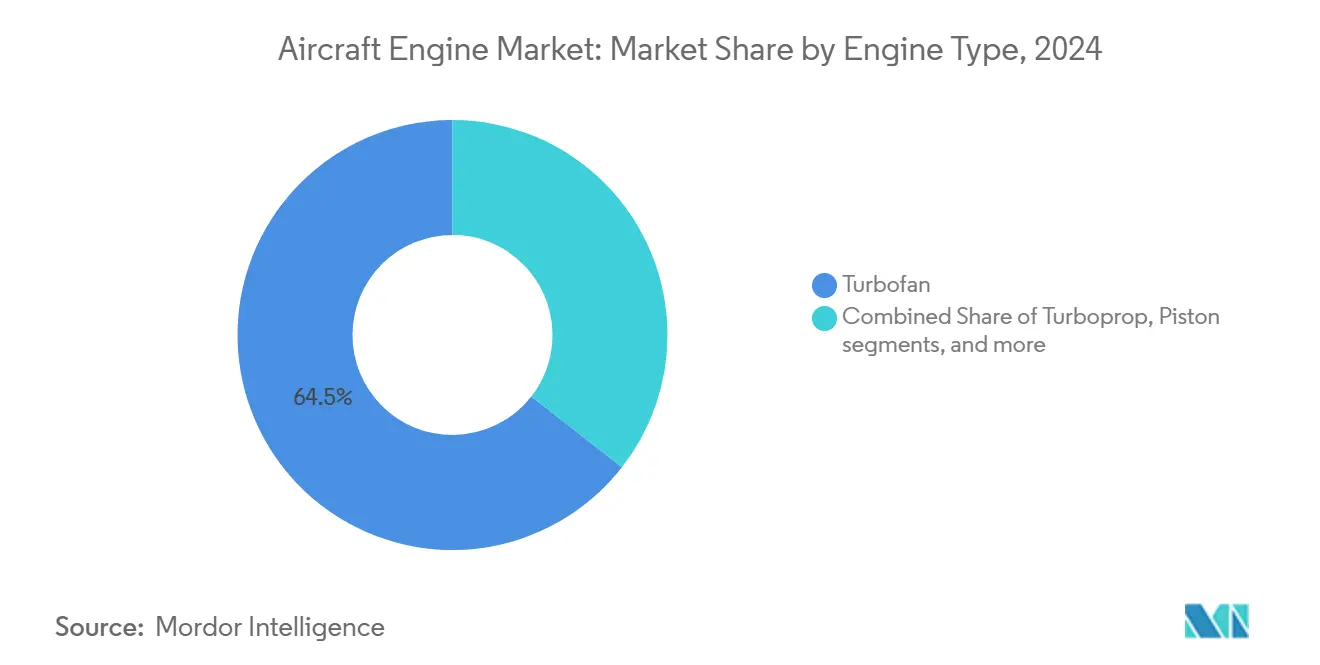
Note: Segment shares of all individual segments available upon report purchase
By Aircraft Type: Narrowbody Leadership Persists
In 2024, narrowbody programs accounted for 43.35% of the aircraft engine market size, primarily driven by the A320neo and B737 MAX families. Airlines favor the seating flexibility and route economics these airframes provide, leading OEMs to prioritize medium-thrust production lines. Widebody propulsion demand is staging a comeback as international travel rebounds, but sustained growth will hinge on punctual certification of the B777X and steady A350 output.
Advanced air mobility (AAM) vehicles represent the fastest-growing application, advancing at a 9.06% CAGR. Vertical Aerospace, Joby Aviation, and other pioneers are flight-testing prototype hybrid-electric VTOL aircraft with ranges up to 1,000 mi, targeting corporate shuttle and regional connectivity markets.[4]AIN Editors, “Hybrid-Electric Propulsion Progress,” ainonline.com Military requirements span from high-performance combat engines, optimized for super-cruise and low observability, to adapted commercial cores in transport and tanker roles. This diversified demand pattern underlines the resilience of the aircraft engine market across aviation segments.
By Technology: Geared Turbofan Acceptance Grows
Geared-turbofan designs achieved 36.13% revenue share in 2024 as airlines validated their 15% fuel-burn advantage over prior-generation engines.[5]FAA, “Hydrogen-Fueled Aircraft Safety Roadmap,” faa.gov The mechanical gearbox decouples fan and low-pressure spool speeds, enabling ultra-high bypass ratios. More than 4,000 GTF-powered aircraft are now on order or in service, despite early teething durability issues that demanded blade-coating improvements and combustor hardware upgrades.
Adaptive-cycle engines lead future-tech growth with a forecast 9.15% CAGR, particularly for sixth-generation fighters that require variable bypass and heat-sink characteristics. CFM’s RISE open-fan program has completed over 250 ground tests, demonstrating 20% efficiency gains versus today’s turbofans. Conventional turbofans and turboprops continue to serve operators with established maintenance networks, but incremental improvements, such as ceramic-matrix-composite hot-section parts, keep these architectures competitive within the aircraft engine market.
By Thrust Class: Mid-Range Units Dominate
Engines rated between 25,001 lbf and 50,000 lbf accounted for 40.5% of the aircraft engine market share in 2024, driven by the substantial volume of A320neo and B737 MAX-series aircraft on firm order books. Volume manufacturing enables economies of scale that lower unit costs and aftermarket part pricing. The greater than 50,000 lbf category is expected to grow at the fastest rate, with a 7.05% CAGR, as long-range twin-engined aircraft regain demand, led by GE9X installations on B777X airframes.
Thrust classes below 10,000 lbf serve business jets and UAVs, where compact cores emphasize weight reduction and rapid spool-up. The 10,001 to 25,000 lbf bracket supports regional jets and military trainers, niches that show moderate growth as emerging markets deepen regional connectivity. Together, these classes ensure the aircraft engine market remains balanced across a broad power spectrum, mitigating the risk of over-reliance on any single program.
By Component: Turbines Drive Value Capture
High-pressure turbines accounted for 36.75% of 2024 revenue, as single-crystal nickel alloys, directional solidification processes, and complex cooling channels increase costs and technological entry barriers. Compressor stages follow closely, leveraging blisk manufacturing to reduce part count and improve aerodynamic efficiency. Variable-area nozzles contribute to noise abatement and thrust optimization, while FADEC and sensor suites integrate digital health monitoring that underpins predictive maintenance.
Gearboxes are the most dynamic component line, projected to post a 5.5% CAGR to 2030. Pratt & Whitney’s GTF reduction gear system operates at 44,000 hp, highlighting the engineering challenge and margin opportunity. Additive-manufactured planetary gears and advanced surface treatments are in qualification, promising weight and durability benefits that will further shape aircraft engine competitiveness. The other components subsegment includes the combined revenue share of fan, combustor, FADEC, and control electronics.

Note: Segment shares of all individual segments available upon report purchase
By End-User: Factory-Fit Still Leads
Original-equipment installations on new airframes continue to account for the majority of delivery volumes. Demand aligns with the incremental ramp-up at final-assembly lines, underscoring the close linkage between aircraft OEM build rates and factory-fit engine shipments.
Aftermarket activity, encompassing overhauls, module exchanges, and long-term service agreements, exhibits the steeper growth curve. Airlines that deferred heavy maintenance in 2020-22 are returning large engines for shop visits, stretching capacity at OEM and independent facilities. Safran’s plan to process 1,200 LEAP shop visits annually by 2028 demonstrates strategic investment in high-value services. Digital twins and predictive analytics platforms are emerging as differentiators as participants compete on turnaround time and cost transparency within the aircraft engine market.
Geography Analysis
The Asia-Pacific region held 33.21% of global revenue in 2024, a position reinforced by high traffic growth, open-skies agreements, and aggressive fleet renewal agendas among low-cost carriers. China's C919 program relies on LEAP-1C propulsion, while India's defense road map now includes potential GE participation in its Indigenous AMCA fighter, which could catalyze local MRO ecosystems. Southeast Asian hubs continue to benefit from tourism rebound and e-commerce logistics, fortifying demand visibility in the aircraft engine market.
North America remains a mature yet lucrative arena where replacement cycles for narrowbody workhorses and defense spending converge. The US Air Force KC-46A tanker and F-35 engine lots sustain high-thrust production, while a dense maintenance footprint anchors the global aftermarket. Sustainable aviation fuel infrastructure pilots in California and Texas also create early adopter opportunities for SAF-ready engines.
Middle East operators headline growth at a 6.75% CAGR, fuelled by fleet expansions at Emirates, Qatar Airways, and Saudia. Harsh desert environments necessitate specialized maintenance, prompting regional MRO joint ventures that leverage OEM technology transfer. Europe maintains its technological leadership through Airbus' final assembly, SAF legislative frameworks, and robust regional jet networks. Africa remains the smallest region but posts the highest proportional fleet-growth forecast, supported by leasing models that lower capital barriers and new route rights under the African Continental Free Trade Area.
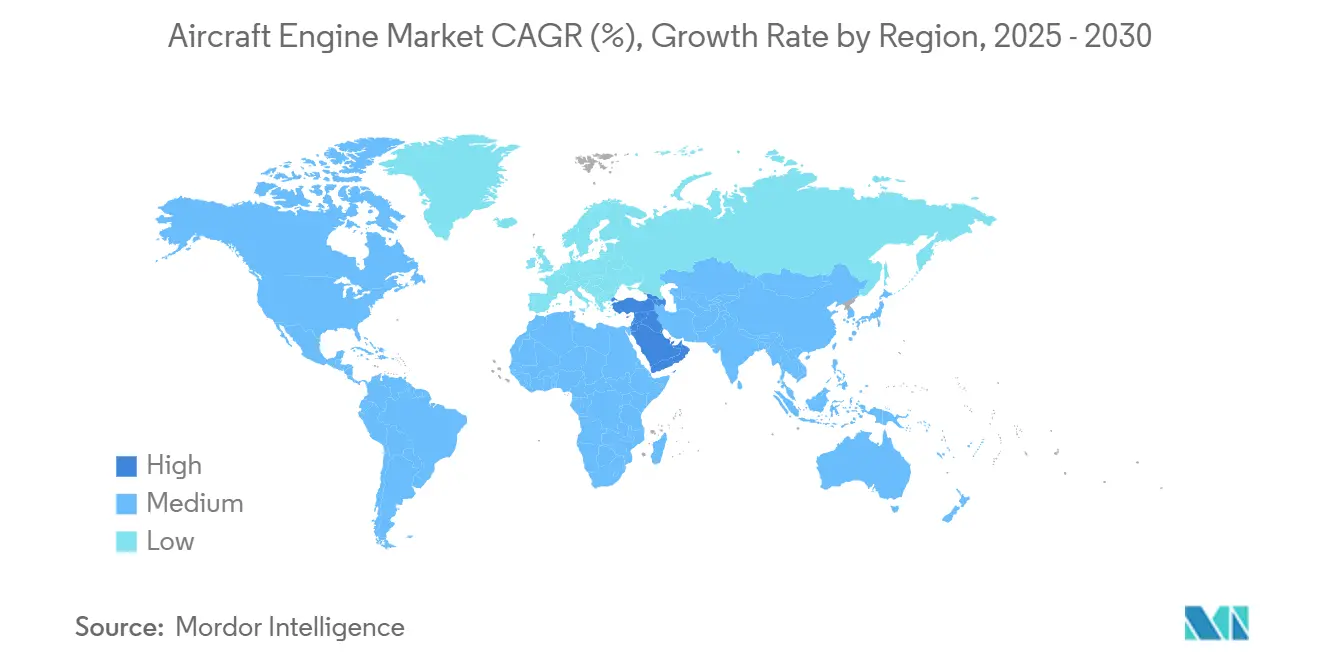
Competitive Landscape
GE Aerospace, CFM International (a joint venture between GE/Safran), Pratt & Whitney, and Rolls-Royce collectively account for major global deliveries, confirming a highly concentrated structure. GE and CFM hold a significant market share through the LEAP, CF34, and GE90 families, leveraging economies of scale in both civil and military programs. Pratt & Whitney powers around one-quarter of the passenger fleet via the GTF and legacy V2500 lines, while Rolls-Royce dominates widebody twin-aisle platforms with its Trent XWB and Trent 7000 models that have clocked more than 145 million flight hours.
Strategic thrusts cluster around two pillars: propulsion efficiency breakthroughs and lifecycle service capture. In partnership with NASA and CFM's open-fan programme, GE Aerospace's demonstrator showcases next-generation architectures in the aircraft engine market. Safran's EUR 1 billion (USD 1.2 billion) investment to triple LEAP overhaul capacity, combined with the Woodward acquisition of Safran's electrical actuation business, reinforces vertical integration plays that secure aftermarket margins.
White-space entrants focus on specialized niches rather than head-on competition. PBS GROUP collaborates with Lockheed Martin on supplies for F-35 subsystems, and Turbotech and Air Liquide validate liquid hydrogen turbines for light aircraft. These alliances foster incremental innovation while relying on established OEM industrial networks for certification pathways and supply-chain resilience.
Aircraft Engine Industry Leaders
-
Safran SA
-
General Electric Company
-
Rolls-Royce plc
-
RTX Corporation
-
Honeywell International, Inc.
- *Disclaimer: Major Players sorted in no particular order
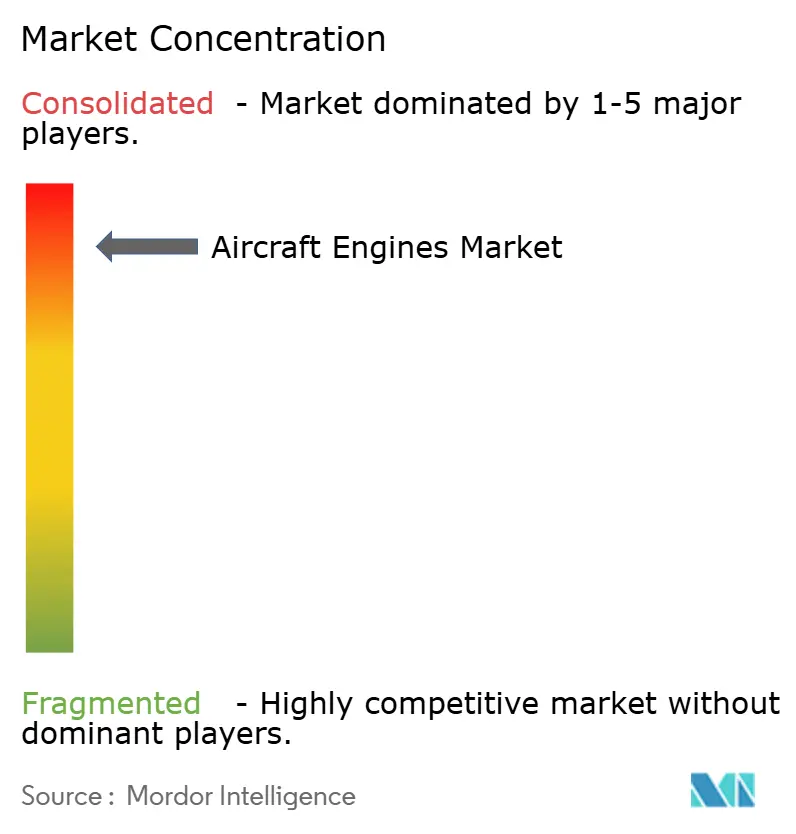
Recent Industry Developments
- June 2025: Wizz Air finalized negotiations to power its incoming A320neo fleet with Pratt & Whitney GTF engines.
- June 2025: GE Aerospace partnered with Kratos Defense to expand small-engine offerings for affordable unmanned systems.
- May 2025: Qatar Airways ordered more than 400 GE9X and GEnx engines, underpinning its forthcoming B777X and B787 arrivals.
- February 2025: GE Catalyst turboprop secured FAA type certification after demonstrating 18% fuel-burn improvement over peer engines.
Research Methodology Framework and Report Scope
Market Definitions and Key Coverage
According to Mordor Intelligence, we define the aircraft engine market as the value of all newly built powerplants installed on fixed- and rotary-wing airframes across commercial, military, and general-aviation fleets; auxiliary power units, used engines, and stand-alone aftermarket parts are out of scope.
Scope Exclusion: After-sale MRO, leased spare engines, and APUs are intentionally excluded to prevent double counting.
Segmentation Overview
- By Engine Type
- Turbofan
- Turboprop
- Turboshaft
- Piston
- Hybrid-Electric
- By Aircraft Type
- Commercial Aviation
- Narrowbody Aircraft
- Widebody Aircraft
- Regional Aircraft
- Military Aviation
- Combat Aircraft
- Non-combat Aircraft
- General Aviation
- Business Jets
- Helicopters
- Turboprop Aircraft
- Piston-Engine Aircraft
- Unmanned Aerial Vehicles (UAVs)
- Advanced Air-Mobility Vehicles (AAM)
- Commercial Aviation
- By Technology
- Conventional Turbofan/Turboprop
- Geared Turbofan (GTF)
- Contra-rotating Open Rotor
- Adaptive-cycle Engines
- Hybrid-Electric Propulsion
- By Thrust Class
- Less than 10,000 lbf
- 10,001 to 25,000 lbf
- 25,001 to 50,000 lbf
- Greater than 50,000 lbf
- By Component
- Compressor
- Turbine
- Nozzle
- Gearbox
- Other Components
- By End-User
- OEM Factory-Fit
- Replacement/Aftermarket
- By Geography
- North America
- United States
- Canada
- Mexico
- South America
- Brazil
- Rest of South America
- Europe
- United Kingdom
- Germany
- France
- Russia
- Rest of Europe
- Asia-Pacific
- China
- India
- Japan
- South Korea
- Rest of Asia-Pacific
- Middle East and Africa
- Middle East
- Saudi Arabia
- United Arab Emirates
- Rest of Middle East
- Africa
- Egypt
- South Africa
- Rest of Africa
- Middle East
- North America
Detailed Research Methodology and Data Validation
Primary Research
We then interviewed aircraft leasing managers, propulsion-system engineers, airline technical-buying heads, and defense acquisition planners across North America, Europe, Asia-Pacific, and the Middle East. These conversations clarified real-world engine lead times, typical pricing brackets, service-life assumptions, and the speed at which hybrid-electric demonstrators may graduate to type certification.
Desk Research
Our analysts first assembled publicly available data from tier-1 authorities such as ICAO traffic statistics, FAA and EASA fleet registers, UN Comtrade HS-8411 trade codes, and Eurostat production indices. We layered these with insights from aviation trade bodies (IATA, AIA) and financial disclosures lodged with the SEC or equivalent regulators. Paid datasets, including Aviation Week orderbook intelligence, Airframer program trackers, and D&B Hoovers company revenues, helped complete delivery pipelines and OEM share splits. The sources cited here are illustrative; many additional publications and databases were consulted during evidence gathering.
Market-Sizing & Forecasting
The base year value emerges from a top-down build using global delivery tallies and fleet retirement schedules, which are then stress-tested with selective bottom-up supplier roll-ups and sampled average selling prices. Key variables, including annual passenger RPK growth, fleet modernization rates, thrust-class mix shifts, SAF blend mandates, and defense procurement outlays, feed a multivariate-regression model; ARIMA smoothing handles short-term shocks. Where bottom-up gaps appear (e.g. classified military volumes), we interpolate using region-specific engine-to-airframe ratios vetted by experts.
Data Validation & Update Cycle
Outputs undergo four-eye analyst review, variance checks against historical margins, and anomaly reconciliation with external indicators before sign-off. We refresh each model annually and trigger interim updates after material events such as major OEM guidance changes or geopolitically driven order spikes.
Why Our Aircraft Engine Baseline Is the Soundest Decision Anchor
Published estimates differ because firms adopt dissimilar scopes, currency bases, and refresh cadences. Some fold in overhaul revenues or legacy spare sales; others convert currencies at spot rather than average rates.
Key gap drivers include inclusion of aftermarket MRO, divergent engine-price curves, and varying assumptions on narrow-body delivery recovery versus wide-body lag. Mordor reports only factory-fresh units and applies a blended ASP ladder that is re-benchmarked each quarter, which curbs overstatement when inflation spikes.
Benchmark comparison
| Market Size | Anonymized source | Primary gap driver |
|---|---|---|
| USD 106.17 bn (2025) | Mordor Intelligence | - |
| USD 63.93 bn (2024) | Global Consultancy A | Excludes military engines and uses delivery counts without price rebasing |
| USD 153.69 bn (2024) | Industry Research B | Adds aftermarket MRO plus APUs and applies list prices |
| USD 75.10 bn (2023) | Research Publisher C | Mixes calendar and fiscal years; partial currency conversion at year-end spot rates |
The comparison shows that figures can swing widely when spare-parts revenue or differing price books creep in. By isolating new-build engines, employing audited delivery data, and updating variables yearly, Mordor Intelligence delivers a balanced, transparent baseline that decision-makers can readily trace and replicate.
Key Questions Answered in the Report
What is the current size of the aircraft engines market?
The aircraft engines market size reached USD 106.17 billion in 2025 and is forecasted to climb to USD 124.84 billion by 2030, expanding at a 3.05% CAGR.
Which engine type dominates global deliveries today?
Turbofan engines dominate, commanding 64.45% of aircraft engines market share in 2024 due to their widespread use on A320neo and B737 MAX families.
Which region is growing fastest for aircraft engine demand?
The Middle East records the highest regional CAGR at 6.75% through 2030, driven by fleet expansion at major Gulf carriers.
How are sustainability regulations influencing engine design?
EU rules mandating progressively higher sustainable-aviation-fuel blends push OEMs to certify engines for 100% SAF operation and to explore hybrid-electric and open-fan architectures.
Why are casting and forging capacities critical bottlenecks?
Specialized turbine-blade alloys require high-precision forging and heat-treatment; limited qualified suppliers constrain output, slowing engine production ramps.
What aftermarket trends should airlines watch?
Shop-visit volumes are rising after pandemic deferrals, prompting OEM and independent MRO networks to expand capacity while offering predictive-maintenance services to cut turnaround times.
Page last updated on:
